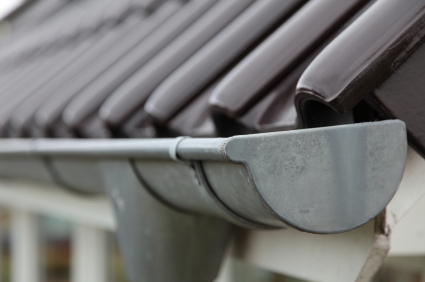Close attention is not always paid to gutters and yet this important roofing element requires regular preventive maintenance. Gutters play a critical role in the entire roofing system and are essential to the exterior maintenance of any house. Eaves troughs direct rainwater off the roof and away from the lower portion of the building.
preventive maintenance. Gutters play a critical role in the entire roofing system and are essential to the exterior maintenance of any house. Eaves troughs direct rainwater off the roof and away from the lower portion of the building.
This important component prevents water from sinking down around the foundation and prevents future damage to the soffit, fascia boards, and exterior paint. A very costly and major problem can occur when water penetrates the foundation of the home. This damage takes place when there are no eaves troughs and downspouts, or the system is installed in a poor location. It is a good idea to make sure that a house has a functioning gutter system.
Structural Composition
Eaves troughs are not necessary for every house. Extended overhangs may route water away from the building with the correct grading and drainage and has the potential to save money during the rainy season. While this may be true, it is still not a guarantee that water will not penetrate and damage the building in the long run. To protect an entire house from pouring rain, a good gutter system should be installed.
A good system will need the following components:
- Various sections
- End cap
- Drop outlet
- Leaf screen
- Hangers or mounting system
- Inside and outside corner or elbow
- Valley shield
- Downspout
Types
There are several options available when it comes to channeling water away from the roof. All of these designs serve one function: to protect the house from the invasion of water. Gutters are made from galvanized steel, aluminum, vinyl or wood. Although wood is rarely used, there are still manufacturers in the United States who can custom match any design using wood to fit individual needs. Galvanized iron is the least expensive and easiest to install; however, it requires more maintenance. The vinyl and aluminum types are lightweight, durable, and resistant to corrosion.
Profile and Sizes
Gutters are shaped into various profiles and sizes. The standard profile is a plain “U” and “K” shape that has an s-shape formed at the front resembling the letters. The channel is approximately 4 to 6 inches in diameter with matching downspouts of 2 by 3 or 3 by 4 inch rectangular profiles. The size of the gutters and downspouts as well as the amount needed depends on the roofing area; the distance between downspouts; the design of the house; and fascia boards.
Eaves troughs can be paired with three different mounting systems. Depending on the type, they are attached to the eaves prior to nailing the roof to the fascia using straps, brackets or hangers.
When there is heavy rain, the roof catches the water sooner and then discharges it to the eaves. With a good gutter system, a house’s siding, walls, windows, and foundation cannot be protected from a heavy downpour. Of course, installing the eaves through a channel is not only essential for routing the water away but also for maintenance purposes. With this in mind, it is imperative to have a professional roofing contractor check and inspect a system to ensure that it is free from debris and in good working condition. By installing this system, along with regular professional inspections, a roof can be safe from any threat of water penetration and the entire building can be protected from damage and costly repairs.
If you are looking for a Houston roofing repair specialist to install or inspect your gutters, Schulte Roofing of Navasota can meet those needs. They provide services to the greater Houston area and can help repair or replace any Houston roof!
